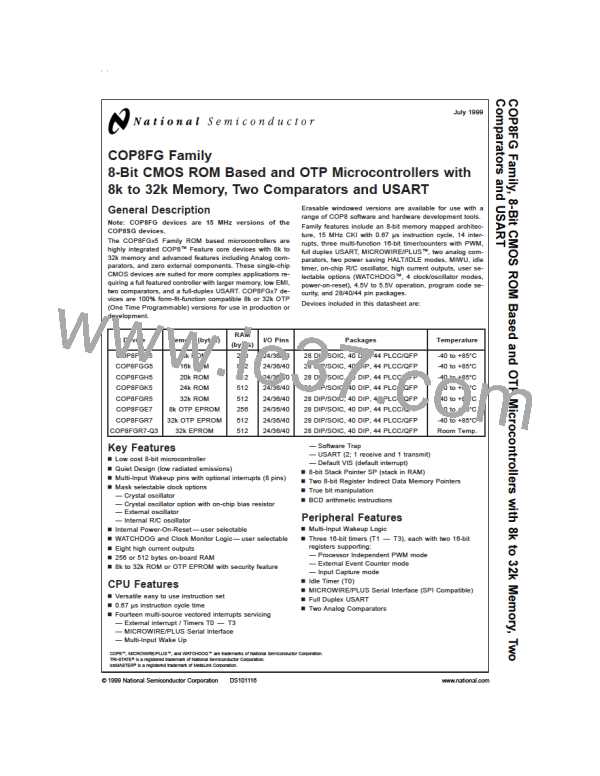11.0 WATCHDOG/Clock Monitor (Continued)
TABLE 9. WATCHDOG Service Actions
Key
Window Clock
Action
Data
Data
Monitor
Match
Match
Match
Valid Service: Restart Service Window
Error: Generate WATCHDOG Output
Error: Generate WATCHDOG Output
Error: Generate WATCHDOG Output
Don’t Care
Mismatch
Don’t Care
Mismatch
Don’t Care
Don’t Care
Don’t Care
Don’t Care
Mismatch
11.3 WATCHDOG AND CLOCK MONITOR SUMMARY
•
Following RESET, the initial WATCHDOG service (where
the service window and the CLOCK MONITOR enable/
disable must be selected) may be programmed any-
where within the maximum service window (65,536 in-
struction cycles) initialized by RESET. Note that this initial
WATCHDOG service may be programmed within the ini-
tial 256 instruction cycles without causing a WATCHDOG
error.
The following salient points regarding the WATCHDOG and
CLOCK MONITOR should be noted:
•
Both the WATCHDOG and CLOCK MONITOR detector
circuits are inhibited during RESET.
•
Following RESET, the WATCHDOG and CLOCK MONI-
TOR are both enabled, with the WATCHDOG having the
maximum service window selected.
•
•
•
•
The WATCHDOG service window and CLOCK MONI-
TOR enable/disable option can only be changed once,
during the initial WATCHDOG service following RESET.
11.4 DETECTION OF ILLEGAL CONDITIONS
The device can detect various illegal conditions resulting
from coding errors, transient noise, power supply voltage
drops, runaway programs, etc.
The initial WATCHDOG service must match the key data
value in the WATCHDOG Service register WDSVR in or-
der to avoid a WATCHDOG error.
Reading of undefined ROM gets zeroes. The opcode for
software interrupt is 00. If the program fetches instructions
from undefined ROM, this will force a software interrupt, thus
signaling that an illegal condition has occurred.
Subsequent WATCHDOG services must match all three
data fields in WDSVR in order to avoid WATCHDOG er-
rors.
The subroutine stack grows down for each call (jump to sub-
routine), interrupt, or PUSH, and grows up for each return or
POP. The stack pointer is initialized to RAM location 06F Hex
during reset. Consequently, if there are more returns than
calls, the stack pointer will point to addresses 070 and 071
Hex (which are undefined RAM). Undefined RAM from ad-
dresses 070 to 07F (Segment 0), and all other segments
(i.e., Segments 4 … etc.) is read as all 1’s, which in turn will
cause the program to return to address 7FFF Hex. It is rec-
ommended that the user either leave this location unpro-
grammed or place an INTR instruction (all 0’s) in this location
to generate a software interrupt signaling an illegal condition.
The correct key data value cannot be read from the
WATCHDOG Service register WDSVR. Any attempt to
read this key data value of 01100 from WDSVR will read
as key data value of all 0’s.
•
•
The WATCHDOG detector circuit is inhibited during both
the HALT and IDLE modes.
The CLOCK MONITOR detector circuit is active during
both the HALT and IDLE modes. Consequently, the de-
vice inadvertently entering the HALT mode will be de-
tected as a CLOCK MONITOR error (provided that the
CLOCK MONITOR enable option has been selected by
the program).
Thus, the chip can detect the following illegal conditions:
1. Executing from undefined ROM.
•
•
With the single-pin R/C oscillator option selected and the
CLKDLY bit reset, the WATCHDOG service window will
resume following HALT mode from where it left off before
entering the HALT mode.
2. Over “POP”ing the stack by having more returns than
calls.
When the software interrupt occurs, the user can re-initialize
the stack pointer and do a recovery procedure before restart-
ing (this recovery program is probably similar to that follow-
ing reset, but might not contain the same program initializa-
tion procedures). The recovery program should reset the
software interrupt pending bit using the RPND instruction.
With the crystal oscillator option selected, or with the
single-pin R/C oscillator option selected and the CLKDLY
bit set, the WATCHDOG service window will be set to its
selected value from WDSVR following HALT. Conse-
quently, the WATCHDOG should not be serviced for at
least 256 instruction cycles following HALT, but must be
serviced within the selected window to avoid a WATCH-
DOG error.
•
•
The IDLE timer T0 is not initialized with external RESET.
The user can sync in to the IDLE counter cycle with an
IDLE counter (T0) interrupt or by monitoring the T0PND
flag. The T0PND flag is set whenever the twelfth bit of the
IDLE counter toggles (every 4096 instruction cycles). The
user is responsible for resetting the T0PND flag.
•
A hardware WATCHDOG service occurs just as the de-
vice exits the IDLE mode. Consequently, the WATCH-
DOG should not be serviced for at least 256 instruction
cycles following IDLE, but must be serviced within the se-
lected window to avoid a WATCHDOG error.
39
www.national.com

 NSC [ National Semiconductor ]
NSC [ National Semiconductor ]